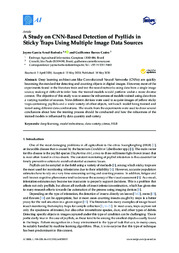A study on CNN-based detection of psyllids in sticky traps using multiple image data sources.
A study on CNN-based detection of psyllids in sticky traps using multiple image data sources.
Autoria: BARBEDO, J. G. A.; CASTRO, G. B.
Resumo: Abstract: Deep learning architectures like Convolutional Neural Networks (CNNs) are quickly becoming the standard for detecting and counting objects in digital images. However, most of the experiments found in the literature train and test the neural networks using data from a single image source, making it difficult to infer how the trained models would perform under a more diverse context. The objective of this study was to assess the robustness of models trained using data from a varying number of sources. Nine different devices were used to acquire images of yellow sticky traps containing psyllids and a wide variety of other objects, with each model being trained and tested using different data combinations. The results from the experiments were used to draw several conclusions about how the training process should be conducted and how the robustness of the trained models is influenced by data quantity and variety.
Ano de publicação: 2020
Tipo de publicação: Artigo de periódico
Unidade: Embrapa Agricultura Digital
Observações
1 - Por padrão são exibidas publicações dos últimos 20 anos. Para encontrar publicações mais antigas, configure o filtro ano de publicação, colocando o ano a partir do qual você deseja encontrar publicações. O filtro está na coluna da esquerda na busca acima.
2 - Para ler algumas publicações da Embrapa (apenas as que estão em formato ePub), é necessário ter, no celular ou computador, um desses softwares gratuitos. Sistemas Android: Google Play Livros; IOS: iBooks; Windows e Linux: software Calibre.
Acesse outras publicações
Acesse a Base de Dados da Pesquisa Agropecuária (BDPA) para consultar o acervo completo das bibliotecas da Embrapa.

